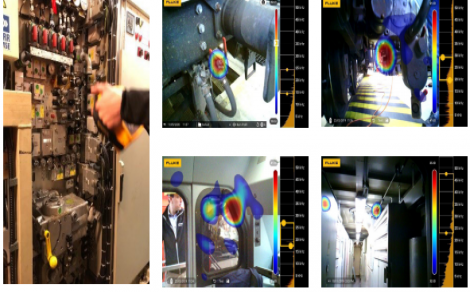- Home » Editorial » Pneumatics
Safety of railway vehicles

In the maintenance of railway vehicles, manufacturers and service centres set high quality standards, which must be carefully tested and documented. Today’s modern vehicles almost resemble a small ‘industrial plant’ that ranges from supply to measurement and control technology.
The fulfilment of these criteria, with the aim of efficient and cost-effective implementation, represents a challenge for technically advanced machines with extensive control technology; both during inspection and maintenance, as well as in troubleshooting during repair. The components are so diverse and versatile that they cannot be checked with a single measuring device. Several different measuring instruments are required to ensure quality and safety.
Fluke ii900 Sonic Industrial Imager enables maintenance managers and engineers to quickly and easily locate leaks in the pneumatic system. The sound source (leakage point) is precisely located using a 64 ultrasonic sensor matrix and displayed in a digital camera as an overlay. A short tour around and through the vehicle is enough to get a good ‘picture’ of the situation. The leak is documented by a simple push of a button.
• Brake system A defect in the pneumatic system of the locomotive or wagons´ brake system can lead to costly damage and compromised safety. It must therefore be avoided.
• Air scaffolding Main distributor of the compressed air with various control, regulating and check valves, throttles and connecting lines. Due to the strong vibrations, leakages can also occur here, which can compromise numerous functions.
• Sanding system is used in rail vehicles to improve friction between wheel and track. The sand is contained in a sandbox and, when necessary, is conveyed by compressed air between the wheels and the track. This system is pneumatically controlled, and its function may be compromised in the event of a leak.
• Air conditioning system is an essential system component in all locomotives and passenger cars. This system, in particular the climate valves, is pneumatically controlled. It must be ensured that the air flow when entering and exiting a tunnel is controlled in accordance with the regulations.
• Cabs and passenger compartments of modern locomotives and trains are press-tight. When entering and exiting tunnels or when two trains encounter at high speed, strong air mass forces act, which jam in front of the moving train. The pressure tightness of the cabin protects the train passengers from serious injuries. The ii900 makes it very easy to control the pressure tightness. By ‘lighting’ the possible leaks, such as entrances, windows, air conditioning or bulkheads.
• Pantographs are pneumatically controlled and monitored. The detection and repair of leaks increases the stability of the system and reduces failure rate during operation. It can also be used in quality control after a repair action is performed.
• Compressed air connections in cars must be checked for tightness during maintenance. Each subsequent car is braked independently due to these connections. The intensity of the braking is carried out on the basis of the compressed air level.
• Doors and locks are also pneumatically controlled and can sometimes have safety relevant impairments. These must be checked at every service check.
Fluke 805 Mobile Vibration Tester is particularly suitable for quick inspection of rotating and mechanical components on the vehicles, such as:
• Unbalance on rotating parts such as wheels, fans, air conditioners, etc.
• Detection of bearing damage on rotating parts
• Vibrations on diesel engines
Note: Experience shows good usability in air cooling systems. In pumps, vibrations are not as pronounced. Here, the noise emission (volume) rather points to worn bearings.
With the help of thermal imaging, it is possible to quickly and safely locate any heat sources caused by errors. This is mainly applied to the following components
• Brakes (heat of the wheel and brake jaws)
• Heating of mechanical and rotating components (e.g. bearings)
• Thermal insulation (e.g. passenger wagons)
• Power electronics in locomotives and wagons
• Solenoid valves
• Fire protection
• Current belts and electrical connection points with high rated current (e.g. high transition resistance)
With the help of a battery tester e.g. Fluke BT521, the integrated battery buffers in the electric locomotives can be checked and their readiness for use (e.g. in case of voltage interruption) can be ensured.
https://www.linkedin.com/company/fluke-corporation/
https://www.facebook.com/FlukeCorpUK/
-
LAMMA Show 2025
15 January, 2025, 8:30 - 16 January, 2025, 16:30
NEC, Birmingham UK -
SOUTHERN MANUFACTURING & ELECTRONICS SHOW 2025
04 February, 2025, 9:30 - 06 February, 2025, 15:30
Farnborough International Exhibition Centre, off Aerospace Boulevard, Farnborough GU14 6TQ -
SMART Manufacturing & Engineering Week
04 - 05 June, 2025
NEC, Birmingham UK -
PPMA 2025
23 September, 2025, 9:30 - 25 September, 2025, 16:00
NEC, Birmingham UK










